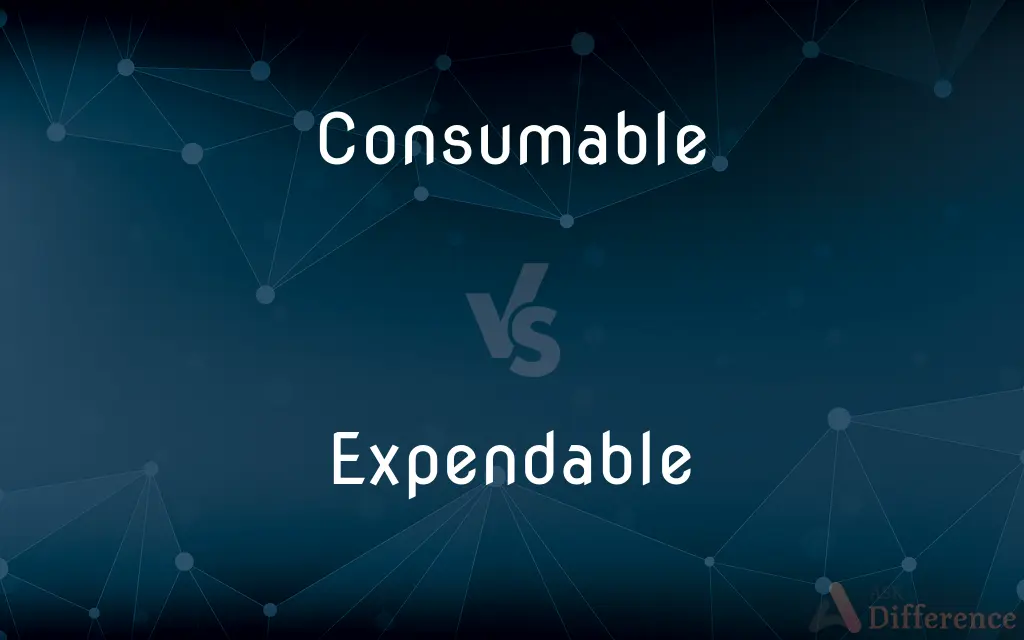Consumable vs. Expendable — What's the Difference?
Edited by Tayyaba Rehman — By Fiza Rafique — Updated on February 24, 2024
Consumables are items meant for consumption and often replaced, like printer ink, while expendables are items used up or consumed, often implying a broader use, including non replenishable resources like fuel.

Difference Between Consumable and Expendable
Table of Contents
ADVERTISEMENT
Key Differences
Consumables are items specifically designed to be used up and then replaced or replenished, often integral to the operation of devices or processes, such as ink cartridges for a printer. Their usage is typically regular and anticipated, part of routine maintenance or operation. Expendables, on the other hand, encompass a wider range of items that can be used up or consumed and not necessarily replaced, including broader categories like office supplies or fuel for vehicles. They are integral to both operational functions and broader logistical considerations.
Consumables often imply a necessity for regular replacement due to their integral role in a process, such as the need for new filters in air purification systems, highlighting their recurring expense and importance in continuous operation. Expendables, while also used up, might not always demand immediate replacement, as their consumption could be based on specific tasks or projects, such as construction materials.
The cost implications of consumables are typically predictable and can be budgeted for as recurring expenses, crucial for operational continuity. Expendables, while also a cost factor, may have variable expenses associated with project-based or ad hoc usage, affecting budgeting and financial planning differently.
Consumables require careful tracking and timely replenishment to avoid operational disruptions, necessitating a proactive approach to supply chain management. Expendables, given their varied use cases, might require a more flexible inventory approach, accommodating fluctuating needs based on project demands or operational requirements.
Environmental considerations also differentiate these terms. Consumables, especially those part of a circular economy, might have sustainable options or recycling programs, like refillable cartridges. Expendables, depending on their nature, may pose environmental challenges, especially if they include single-use items or materials with limited recycling options, highlighting the importance of sustainable usage practices.
ADVERTISEMENT
Comparison Chart
Definition
Items meant to be consumed and replaced regularly.
Items used up or consumed, not necessarily with a plan for immediate replacement.
Usage
Integral to the operation of devices or systems, like ink in printers.
Broad usage, including materials for projects or fuel.
Cost Implications
Predictable, recurring expenses.
Variable, can be project-based or ad hoc.
Inventory Management
Requires careful tracking and timely replenishment.
May need a flexible approach due to fluctuating needs.
Environmental Impact
Often part of circular economies with sustainable options.
Can pose challenges, especially with single-use items.
Compare with Definitions
Consumable
Printer ink cartridges are consumables that need regular replacement.
We order new printer ink cartridges every month to ensure we don't run out.
Expendable
Construction materials are expendables in building projects.
Ordering the right amount of construction materials is crucial to keep the project within budget.
Consumable
Coffee and tea supplies in a workplace are consumables.
The company replenishes coffee and tea supplies weekly for employee use.
Expendable
Able to be expended; not inexhaustible.
Oil and other expendable resources are frequently the subject of military disputes.
Consumable
Laboratory reagents are consumables necessary for ongoing experiments.
We must order more laboratory reagents for next month's experiments.
Expendable
Office stationery, like pens and paper, are considered expendables.
We need to stock up on office stationery before the next project starts.
Consumable
A material or product that is produced for consumption.
Printer consumables such as toner and ink cartridges
Expendable
Batteries for electronic devices are expendables.
We keep extra batteries on hand, as they're an expendable item we frequently use.
Consumable
Cleaning supplies in an office are considered consumables.
We keep a steady stock of cleaning supplies to maintain office hygiene.
Expendable
Single-use medical supplies are expendables in healthcare settings.
The hospital ensures a continuous supply of single-use medical supplies for patient care.
Consumable
Capable of being consumed
Consumable energy.
Expendable
Fuel for vehicles is an expendable resource.
The company allocates a monthly budget for vehicle fuel, an essential expendable.
Consumable
Capable of being consumed; that may be destroyed, dissipated, wasted, or spent.
Consumable
Air filters for HVAC systems are consumables that require periodic replacement.
It's time to replace the air filters in the HVAC system to ensure air quality.
Common Curiosities
How do consumables differ from expendables in terms of replacement?
Consumables require regular replacement as part of routine operations, while expendables' replacement may vary based on specific tasks or project needs.
Can an item be both consumable and expendable?
Yes, the context of use can determine whether an item is considered consumable or expendable, such as paper being a consumable in an office printer and an expendable in packaging.
Why is it important to differentiate between consumables and expendables?
Understanding the difference helps in budgeting, inventory management, and environmental impact considerations, ensuring efficient and sustainable operations.
What are expendables?
Expendables are items that are used up or consumed and may not necessarily be replaced immediately, including broader categories like fuel or construction materials.
How do consumables affect operational budgets?
Consumables represent predictable, recurring expenses that can be budgeted for in advance, integral to maintaining operational continuity.
What kind of inventory management is required for consumables?
Consumables require careful tracking and timely replenishment to avoid operational disruptions, necessitating proactive supply chain management.
What are consumables?
Consumables are items designed to be used up and then regularly replaced or replenished, such as printer ink or laboratory reagents.
How can businesses manage expendable resources efficiently?
Efficient management involves flexible inventory approaches and careful budgeting to accommodate fluctuating needs and minimize waste.
Are expendables more variable in cost than consumables?
Yes, the cost of expendables can be more variable, affected by project-based or ad hoc usage, which impacts budgeting and financial planning.
How can businesses reduce the environmental impact of expendables?
Adopting sustainable practices, choosing recyclable or reusable options, and minimizing waste are key strategies for reducing the environmental impact of expendables.
Do expendables pose environmental challenges?
Yes, especially single-use items or materials with limited recycling options, highlighting the importance of sustainable usage practices.
Can recycling programs mitigate the environmental impact of consumables?
Recycling programs and sustainable options for consumables can significantly reduce environmental impact, promoting a circular economy.
What role do consumables play in continuous operation?
Consumables are crucial for the continuous operation of devices or systems, requiring regular replacement to avoid disruptions.
What environmental considerations are there for consumables?
Consumables, especially in circular economies, might have sustainable options or recycling programs, reducing environmental impact.
How do project demands affect the usage of expendables?
Project demands can lead to fluctuating needs for expendables, requiring flexible inventory and budgeting approaches.
Share Your Discovery

Previous Comparison
Saving vs. Savings
Next Comparison
Catsuit vs. JumpsuitAuthor Spotlight
Written by
Fiza RafiqueFiza Rafique is a skilled content writer at AskDifference.com, where she meticulously refines and enhances written pieces. Drawing from her vast editorial expertise, Fiza ensures clarity, accuracy, and precision in every article. Passionate about language, she continually seeks to elevate the quality of content for readers worldwide.
Edited by
Tayyaba RehmanTayyaba Rehman is a distinguished writer, currently serving as a primary contributor to askdifference.com. As a researcher in semantics and etymology, Tayyaba's passion for the complexity of languages and their distinctions has found a perfect home on the platform. Tayyaba delves into the intricacies of language, distinguishing between commonly confused words and phrases, thereby providing clarity for readers worldwide.















































